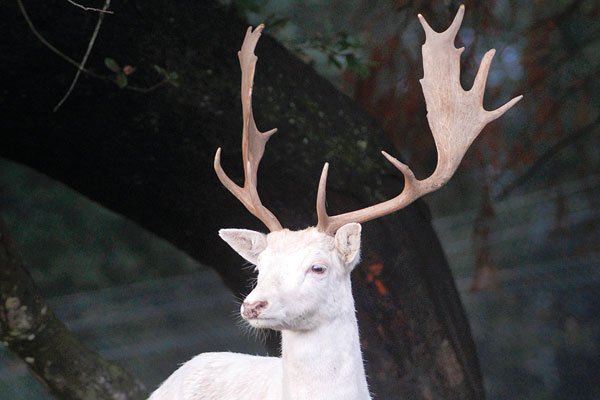Nobody knows for sure if William Randolph Hearst anticipated
that a gift could bring amusement and joy to thousands into the
21st century. Or, if Hearst could have predicted the two pairs of
the (then)
”
exotic
”
animals would eventually become an attraction that generations
of families would drive a winding mountain road to see for
themselves.
But that is the case, just not for long.
Nobody knows for sure if William Randolph Hearst anticipated that a gift could bring amusement and joy to thousands into the 21st century. Or, if Hearst could have predicted the two pairs of the (then) “exotic” animals would eventually become an attraction that generations of families would drive a winding mountain road to see for themselves.
But that is the case, just not for long.
In 1934, two pairs of white fallow deer were donated to Mount Madonna just two years after opening its gates as a county park, and they have since been living in large viewing pens which currently encompass more than two acres.
In past years, the herd has included as many as 58 deer, but today all that remain are 15 females (does) and two males (bucks). The fallow deer are grazing animals with a preferred habitat of mixed woodland and open grassland. What makes this species of deer visually unique is not just the lighter colored fur than that of our local native black-tailed deer, but also because the buck grows impressive broad antlers, while the doe does not grow antlers at all. Some might say the buck resembles an image of a traditional Christmas reindeer, and because of that resemblance, attendance for viewing the animals seems to be higher around Christmas time. The deer are not accessible for human interaction in a petting zoo setting, but have been known to approach the tall fences for hand feeding by park guests.
Even though generations of families have enjoyed viewing and feeding the white fallow herd for the past 74 years, Santa Clara County Parks Public Information Officer Tamara Clark-Shear said this will be the last generation of deer at the park.
“The bucks and does have been separated to prevent repopulating due to known potential health risks caused by too many years of inbreeding, which creates hereditary genetic issues and unhealthy animals,” she said.
White fallow deer are not considered to be an endangered species. Although they are not originally indigenous to this area – they originate from the Mediterranean and Asia Minor – the deer are thriving in northern California. At Point Reyes National Park the free roaming while fallow deer are so abundant they are actually becoming a nuisance, and according to a Point Reyes National Seashore deer report, “the fallow deer are extremely disruptive to the seashore’s natural ecosystem. Some of the more serious effects include competition for the same food and displacement of the native tule elk and black-tailed deer.”
When asked if it was an option to integrate white fallow deer from the Point Reyes Park to breed with the local herd, Clark-Shear affirmed that Mount Madonna cannot meet the USDA state regulations required to actively keep and populate the deer pen areas.
“The book of regulation standards has a couple hundred pages of requirements in order to provide an animal attraction,” she said. “And our park is staffed with five park rangers, we are not zoo keepers. We would have to hire specific staff to care for the animals. Zoo keeping is an entirely different business.”
Clark-Shear also said the resident deer have been traumatized from being in enclosed areas and shot at in years past by unknown persons. In addition, there have been 12 to 15 mountain lion attacks in the last year. The park rangers have since taken precautions to protect the herd from mountain lions by keeping the trees trimmed back and maintaining electrified fence lines. So far this has deterred the predators.
Don Rocha, the natural resource program supervisor, said the cannot let the deer roam free.
“If the deer were set free to roam as they have done at Point Reyes they would breed with local deer and create a new sub species, but we cannot allow that because this herd has a low immune system from so many years of being isolated and inbreeding,” he said. “This could damage the immune systems of future generations of free roaming deer, creating a new weaker breed. For that same reason, they cannot be taken to a zoo and risk compromising hidden diseases they may carry and possibly infecting other animals.”
It is in the best interest of the herd to attrition out naturally, Clark-Shear said. This is “the most humane course of action under the circumstances.” The remaining deer are well cared for and fed alfalfa and a molasses/oat mix daily. They are seen twice a year by DVM Greg Martinez of Gilroy Veterinary Hospital.
Although this nostalgic attraction will come to an inevitable end, the white fallow deer are still available for viewing and have a natural life expectancy of 10 to 15 more years. If you would like to visit the deer pens at Mount Madonna County Park, it is located about 10 miles west of Gilroy, off Highway 152. The park entrance is at the summit and is open daily at 8 a.m., and closes at sunset. A $6 car entrance fee is required.
A percentage of that charge is applied to the maintenance and care of the white fallow deer.















